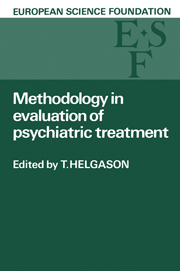 Methodology in Evaluation of Psychiatric Treatment
Methodology in Evaluation of Psychiatric Treatment from II - EVALUATION CRITERIA
Introduction
In talking about measurement of the effects of psychotherapy, one has to remember that the treatment is not well understood by many colleagues. They often imagine psychotherapy as being an exotic ‘soft’ or 'cosmetic’ treatment with unmeasured or unmeasurable outcomes, conducted only by expensively trained individuals in the secrecy of their nicely appointed offices.
Dewald (1964) has defined psychotherapy as a “psychological process between two or more individuals, in which one (the therapist) by virtue of training and position, seeks systematically to apply psychological knowledge and interventions in an attempt to understand, influence and ultimately modify the psychic experience, mental function and behaviour of the other (the patient)”.
One has to decide if psychotherapy has any effects at all, good or bad, or whether psychotherapy is an effective form of treatment; if so is it an efficient form, i.e. is it cost effective?
The most extensive criticisms of the efficacy of psychotherapy are perhaps those of Hans Eysenck (1952). His pessimistic conclusions were based on 24 surveys of treatment conducted both at psychoanalytic and other clinics. They reported uncontrolled compilations of clinical statistics using ill-defined therapist judgements of patient functioning or improvement as the only diagnostic and outcome criteria. Eysenck uncritically pooled these data and compared the findings and outcome of the natural course of neurosis. One of these studies reported data collected by insurance adjusters to adjudicate disability claims, while the other reported the percentage of neurotic patients released from New York State Hospitals as recovered or improved from 1917 to 1934. He attempted to construct a base-line for psychological improvement of neurosis in the absence of treatment, i.e, a spontaneous remission rate. This remission rate was compared with recovery rates in the 24 survey studies. He concluded that spontaneous remission was as effective as treatment given during psychological therapy. Eysenck supported his view in later reviews (1960, 1965) using selected control studies.
There has been no shortage of critics to expose Eysenck's mistakes and biases (Bergin & Lambert 1978; Malan 1973). Particularly it has been pointed out that Eysenck has used essentially dissimilar populations and that spontaneous remission rates from other sources are much more variable, ranging from 18 to 67 per cent. His review of the then available literature was biased and incomplete.
To save this book to your Kindle, first ensure [email protected] is added to your Approved Personal Document E-mail List under your Personal Document Settings on the Manage Your Content and Devices page of your Amazon account. Then enter the ‘name’ part of your Kindle email address below. Find out more about saving to your Kindle.
Note you can select to save to either the @free.kindle.com or @kindle.com variations. ‘@free.kindle.com’ emails are free but can only be saved to your device when it is connected to wi-fi. ‘@kindle.com’ emails can be delivered even when you are not connected to wi-fi, but note that service fees apply.
Find out more about the Kindle Personal Document Service.
To save content items to your account, please confirm that you agree to abide by our usage policies. If this is the first time you use this feature, you will be asked to authorise Cambridge Core to connect with your account. Find out more about saving content to Dropbox.
To save content items to your account, please confirm that you agree to abide by our usage policies. If this is the first time you use this feature, you will be asked to authorise Cambridge Core to connect with your account. Find out more about saving content to Google Drive.